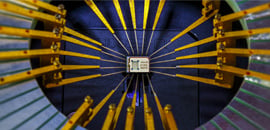With Sensor1 at α = 0°, its Phase Error (Ψ) is:
Ψ 1 (θ) = ( 360 / λ ) ε sin(θ)
With Sensor2 at α = 180°, directly opposite Sensor1, its Phase Error (Ψ) is:
Ψ2 (θ) = ( 360 / λ ) ε sin(180 + θ) = − ( 360 / λ ) ε sin (θ)
By triggering of the signal from Sensor1 we are observing the other sensor from a new reference frame; one that varies in phase with Sensor1. From this new reference frame we see the Phase Errors varying as Ψn’ (θ).
Ψn ‘(θ) = Ψn (θ) – Ψ1 (θ)
Ψ n ‘(θ) = Ψn (θ) – (360 / λ) ɛ sin (θ)
The signal from Sensor1 appears to stand still since;
Ψ 1 ‘(θ) = Ψ1 (θ) – (360 / λ) ɛ sin (θ) = (360 / λ) ɛ sin (θ) – (360 / λ) ɛ sin (θ) And the phase error variation of Sensor2 is given by:
Ψ 2 ‘(θ) = Ψ2 (θ) – (360 / λ) ɛ sin (θ) = – (360 / λ) ɛ sin (θ) – (360 / λ) ɛ sin (θ)
Ψ 2 ‘(θ) = -2 [ (360 / λ) ɛ sin (θ) ]
Now consider that l is a constant for a given scale (20 µm) and ɛ is a constant for a given alignment. Therefore, Ψ2’ is simply a sinusoidal function of the rotating shaft angle (θ) with amplitude.
Amplitude = 2 [ (360 / λ) ɛ ]
Thus the phase error variation appears to oscillate with twice the actual amplitude of the eccentricity.
The total swing of the oscillation that appears on the oscilloscope is the peak to peak value of this equation, and it is twice the amplitude of Ψ2’ or four times the actual amplitude of the eccentricity.
Total Swing (number of fringes) = 2 x 2 x [ (360 / λ) ɛ ] = 4 [ (360 / λ) ɛ ]
The eccentricity can be calculated from the total swing from Sensor2.
ɛ = [ λ Total Swing (number fringes) / (4 x 360°) ]
Since one fringe is = 360 ° and λ is equal to 20µm for Mercury encoder the equation can be reduced to
ɛ = 5 x Total Swing (number fringes)

























